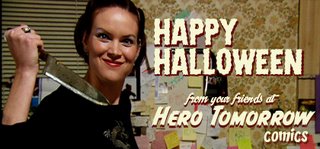Tuesday, October 31, 2006
Thursday, October 19, 2006
Party at Spaces - Shag & Stripes

On an unrelated Hero Tomorrow note:
SPACES annual benefit party and auction always proves to be one of the year's most colorful, outrageous and creative events in Cleveland.
Based on a theme, guests come dressed in varying degrees of that theme, from mild to wild. And its silent art auction has consistently been recognized as one of the best opportunities to get great work by emerging and established regional artists.
This year's theme is SHAG & STRIPES - Saturday November 4th, 2006.
Shag: Think 70s bungalow. Austin Powers. Or a small water bird.
Stripes: As in "stars and. . ." Or maybe pinstripes. Animal stripes (zebra, tiger, skunk?).
Tickets range from $40 to $125. I'll be there all night with my wife Diane-Davis Sikora who is co-chairing the event this year. Hope to see some of you there. Please try to request a seat at our table if you're attending the Penthouse Party.
All the info is at the SPACES website
SPACES
2220 Superior Viaduct
Cleveland OH 44113
216-621-2314
Friday, October 13, 2006
Color Correction & Mastering
I haven’t really found much on this subject, so I thought I’d share this for those in a perhaps similar quandary.
I spent seven years as a mastering engineer at a fine audio duplication facility in Fairview Park called A to Z Audio. A mastering engineer basically takes audio mixes from studios, bands – anyone really - and equalizes, enhances, and compresses the mix so that it will sound as nice as it can for the client. One of the challenges of mastering is keeping in mind all of the possible ways that the mix might be played – car stereos, home systems, radio airwaves, walkmans, etc.
Most clients would come in and immediately want to boost the bass and treble because that’s how they like their music. I had to often explain to them that if I boost it mastering, and the listener boosts it on their stereo (as most people do – - as do the radio stations) it’s going to have twice the ‘preferred’ bass and treble. Mastering, therefore involves the unsung art of allowing a person to crank up the bass without turning their woofers to confetti.
So last week I’m working on color correction for HERO TOMORROW, and on a nicely calibrated video monitor I boosted the color and brightness so everything looked really sweet. I rendered it out, burned a DVD, took it down to the TV, and was quite bummed to see how over-saturated and bright the whole thing looked. I spent the better part of a day puzzled until I started remembering my days at A to Z. Applying the 'audio bass and treble' boost to the 'TV saturation-brightness' boost, I figured out the source of my problem. TV manufacturers want their sets to look more colorful and vibrant than the 90 other sets on display at Best Buy, so they calibrate their TVs with far more color volume than what is recommended in a professional viewing environment.
So color correction, like mastering, is really not only a matter of making the film look great in a monitor setting. It’s also making it clean, safe, and workable for all systems. A bit of a setback - yes, but another great lesson learned.
I spent seven years as a mastering engineer at a fine audio duplication facility in Fairview Park called A to Z Audio. A mastering engineer basically takes audio mixes from studios, bands – anyone really - and equalizes, enhances, and compresses the mix so that it will sound as nice as it can for the client. One of the challenges of mastering is keeping in mind all of the possible ways that the mix might be played – car stereos, home systems, radio airwaves, walkmans, etc.
Most clients would come in and immediately want to boost the bass and treble because that’s how they like their music. I had to often explain to them that if I boost it mastering, and the listener boosts it on their stereo (as most people do – - as do the radio stations) it’s going to have twice the ‘preferred’ bass and treble. Mastering, therefore involves the unsung art of allowing a person to crank up the bass without turning their woofers to confetti.
So last week I’m working on color correction for HERO TOMORROW, and on a nicely calibrated video monitor I boosted the color and brightness so everything looked really sweet. I rendered it out, burned a DVD, took it down to the TV, and was quite bummed to see how over-saturated and bright the whole thing looked. I spent the better part of a day puzzled until I started remembering my days at A to Z. Applying the 'audio bass and treble' boost to the 'TV saturation-brightness' boost, I figured out the source of my problem. TV manufacturers want their sets to look more colorful and vibrant than the 90 other sets on display at Best Buy, so they calibrate their TVs with far more color volume than what is recommended in a professional viewing environment.
So color correction, like mastering, is really not only a matter of making the film look great in a monitor setting. It’s also making it clean, safe, and workable for all systems. A bit of a setback - yes, but another great lesson learned.



